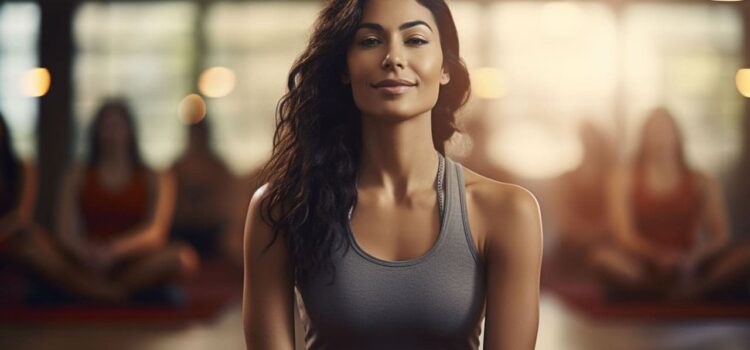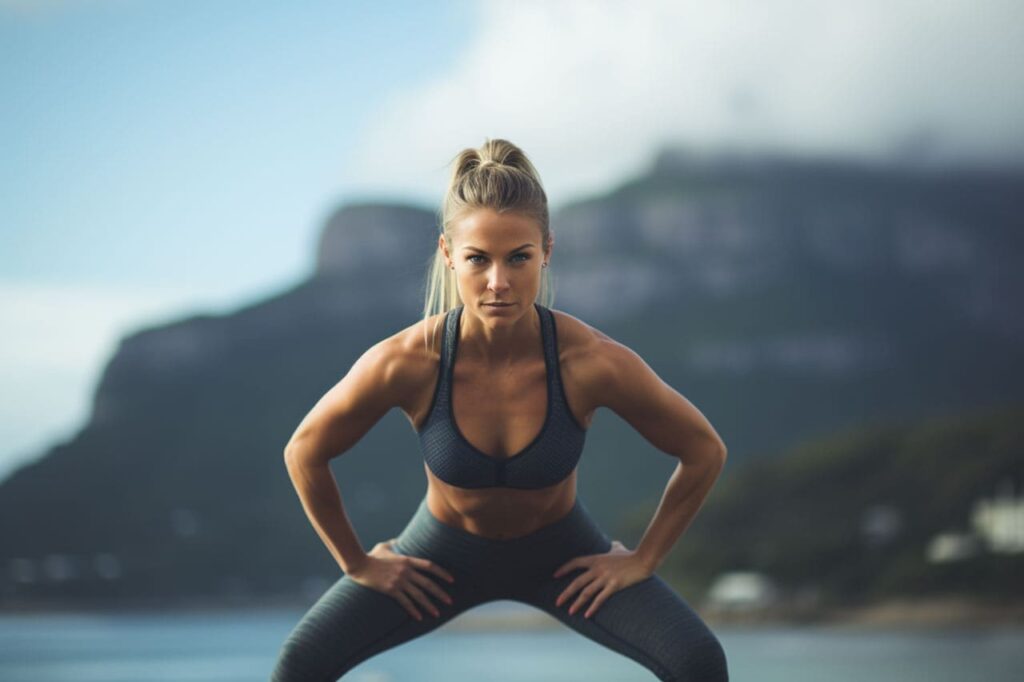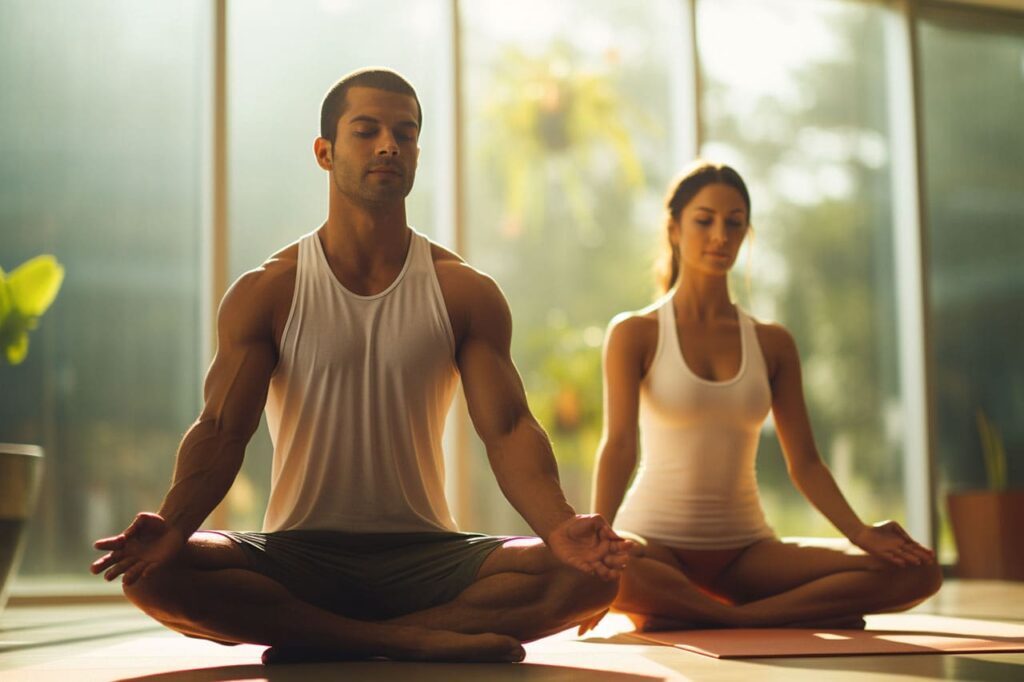

How to Improve Your Half Marathon Performance with Yoga
Cross-Training for Half Marathons July 1, 2023 admin 0

You’ve been training for your half marathon for months now, haven’t you? You’re pounding the pavement, tracking your mileage, and pushing your body to its limits. But have you ever considered how yoga might give you that extra edge you need? I’m not joking! As a runner, you might overlook yoga as a cross-training exercise, but it’s time to rethink that. You can improve your half marathon performance with yoga.
Yoga isn’t just about flexibility and zen-like calmness. It’s a powerhouse for improving strength, flexibility, and mental focus, all of which are crucial for a half marathon. So, if you’re ready to power up your performance, let’s dive into how yoga can become your secret weapon. It’s time to become the best half marathoner you can be!
Understand the Basics of Yoga
After experiencing the benefits of yoga firsthand, I can’t wait to share them with you. Then, let’s dive into the various types of yoga, so you can find the style that suits you best. Finally, I’ll give you some crucial safety tips to ensure your yoga practice is as safe as it is transformative.
Benefits of Yoga
Paving our way from the fascinating history of yoga, let’s dive deeper into the heart of the practice. Imagine digging into a treasure chest of benefits that not only enhances your physical fitness but also enriches your mental wellness. That’s exactly what yoga offers!
The benefits of yoga are vast and transformative. It’s like a magic potion that heals us from the inside out. When we practice yoga, we’re not just stretching our bodies, we’re also stretching our minds. You’ll notice improvements in flexibility, strength, and balance. But what’s even more amazing is how it aids in stress reduction. It’s been proven that regular yoga practice helps lower cortisol levels, the stress hormone. And let’s not forget how yoga can boost heart health and promote better sleep patterns. Truly, yoga is not just a workout, it’s a work-in!
Types of Yoga
Diving headfirst into the ocean of Yoga, let’s explore the various types we can immerse ourselves in. You’d be surprised to know that Yoga isn’t just one size fits all, it has a myriad of types, each with its distinctive style and benefits.
The most commonly practised type is Hatha Yoga, ideal for beginners due to its slow-paced nature. If you’re looking for a challenge, Ashtanga Yoga, with its demanding series of poses, will give you a real workout. For those who crave a unique twist, Aerial Yoga allows you to perform poses while suspended in the air! And let’s not forget Kundalini Yoga, which blends spirituality with physical postures. Remember, you don’t have to stick to just one type. Feel free to experiment and find the one that suits you the best.
Safety Tips for Practicing Yoga
Moving from the copious benefits and diverse types of yoga, it’s essential to pivot our attention towards ensuring our yoga practice is safe and beneficial. Let’s dive into some solid safety tips for practicing yoga.
First things first, don’t push yourself too hard. It’s not a competition, it’s a journey. Listen to your body and respect its limits. If a pose feels too challenging, it’s okay to modify it or skip it altogether. And remember, consistency is key. Regular, moderate practice will yield better results than occasional, intense sessions. Another crucial tip is to warm up before starting your routine. It prepares your body for the exercises and it reduces the risk of injuries. Lastly, if you’ve any pre-existing medical conditions or injuries, always consult a health professional before starting a new exercise routine. Your safety is paramount, so take these tips to heart and enjoy a safe and fulfilling yoga journey.
Develop a Yoga Routine
First off, let’s dive right into choosing the right yoga style – it’s crucial to find what suits your body and mind. Once we’ve nailed that, we’ll jump into creating a yoga sequence that’ll challenge you, but also, keep things interesting. Lastly, but certainly not least, we’ll tackle setting a regular practice because consistency is how we’re gonna get you to that zen state.
Choose the Right Yoga Style
Now that we’ve got the basics of yoga down, it’s time to step up our game and start crafting a personal yoga routine. The first step of this process is choosing the right yoga style that resonates with you and your goals.
There are a plethora of yoga styles out there, and finding the one that’s right for you can feel daunting. However, don’t be intimidated. It’s crucial to understand that every style has its own unique benefits and challenges. If you’re looking for something calming and restorative, consider Yin or Restorative yoga styles. On the other hand, if you’re into something more dynamic and physically challenging, Vinyasa or Ashtanga may be more your speed. It all comes down to what you’re looking to gain from your yoga practice. So, trust your intuition and listen to your body, it knows what’s best for you!
Create a Yoga Sequences
Having grasped the fundamentals of yoga, let’s dive into the heart of developing your personalized yoga routine. A critical step in this process is creating your own yoga sequences.
Now hold on, don’t panic, it’s not as complicated as it sounds! You can simply start by picking a few basic poses that you’re comfortable with and practice transitioning between them. Trust me, you’ll get the hang of it in no time. It’s all about creating a flow that feels natural to you, and remember, there’s no rush or right way to do it. It’s your yoga journey, so make it what you want it to be!
Set a Regular Practice
Stepping off the mat, you’re filled with a sense of tranquility you’ve never experienced before. The world around you seems more vibrant, your mind is clear, and your body feels alive. But how do you turn this newfound passion into a regular practice? Let’s dive in.
Setting a regular yoga practice is easier than you’d think. It’s like creating your favorite coffee blend – a little bit of this, a little bit of that, and whoosh! There you have it. First, decide on a suitable time that works for you. You’re in charge here, so don’t let the world dictate when you should or shouldn’t do your yoga. You’re a morning person? Great! Do it then. More of a night owl? That’s perfect too. Consistency is key, so aim for a time you can stick with. Remember, it’s your journey, it’s your practice. Be bold, be consistent, and embrace your inner yogi.
Improve Strength and Flexibility

First, let’s dive into the key target muscles you’ll need to focus on for running, because understanding these can significantly boost your performance. Then, we’ll explore how to improve your mobility and stability, which are vital to not just running, but your everyday movements too. Lastly, we’ll tackle how to balance strength and flexibility – because having both in harmony can really take your fitness to the next level.
Target Muscles for Running
Shifting gears from our yoga mats to the running tracks, let’s focus on something that’s equally crucial for any fitness enthusiast – targeting the right muscles for running. It’s no secret that running engages a plethora of muscles, but we need to focus on those that truly fuel our stride. We’re talking about our glutes, quadriceps, hamstrings, calves, and core.
To get the most out of our runs, we’ve gotta work these muscles in our cross-training sessions. Remember, stronger muscles mean better performance. So, let’s commit to pumping up those quads, firing up that core, and pushing our glutes to the limit. When we start focusing on these muscles, we’ll notice a substantial difference in our running stamina, speed, and stability. It’s going to be tough, but hey, we’re tougher!
Improve Mobility and Stability
Shifting gears from our yoga routine, let’s dive headfirst into the realm of mobility and stability. It’s not just about being able to reach down and touch your toes, folks. We’re talking about real, functional mobility. The kind that lets you run faster, lift higher, and live better.
Here’s the deal: improving mobility and stability isn’t a walk in the park. It’s going to take grit, determination, and a little bit of sweat. But trust me, it’s worth the effort. By focusing on exercises that enhance mobility, you’re not just improving your range of motion. You’re also helping to stabilize your joints, which can lead to fewer injuries and better performance. So let’s get to work, shall we?
Balance Strength and Flexibility
Alright, now that we’ve mapped out a fabulous yoga routine, let’s dive deeper into the crux of our fitness journey. We’re going to focus on balancing strength and flexibility, which is vital not only for runners, but for anyone looking to keep their bodies strong, supple, and injury-free.
Balancing strength and flexibility is all about harmony. You’re not just building strong muscles, but also ensuring they’re flexible enough to support a wide range of motion. Think of your body as a finely-tuned machine, where every part works in unison. Power through your strength training exercises, but always make time for stretching sessions too. It’s this interplay of strength and flexibility that will keep you moving smoothly and effortlessly, whether you’re running a marathon or simply going about your day. Let’s own this journey, pushing our bodies to become the best version of themselves!
Prepare the Mind and Body for Running
The mental game in running is key. In our journey to prepare for running, let’s first delve into the importance of practicing relaxation techniques; it’s a game-changer in managing stress and enhancing performance. Next, we’ll explore how to develop mental clarity and focus, both critical components in maintaining a steady pace. Lastly, let’s dive deep into the ways we can increase our endurance and stamina, as they’re the fuel that’ll help us go the distance.
Practice Relaxation Techniques
Having sculpted your body to peak strength and flexibility, it’s time to turn inward and prepare our minds for the dynamic journey of running. The first step in this mental conditioning is to practice relaxation techniques.
Believe it or not, running is as much mental as it is physical. You might be surprised just how much tension you’re unknowingly carrying. This unnecessary tension can be a severe roadblock to your running performance. Here’s where relaxation techniques come in. Whether it’s yoga, meditation, or deep-breathing exercises, it’s vital to learn how to release this tension. By doing this, not only will you feel lighter and more agile, but you’ll also see a significant improvement in your running endurance. So, let’s get our zen on and start relaxing!
Develop Mental Clarity and Focus
Now that we’ve pumped up our strength and flexibility, it’s time to harness the power of our minds! The mental aspect of running is just as important, if not more so, than the physical.
Developing mental clarity and focus can truly elevate your running game. It’s not just about getting your body in motion, it’s about getting your mind in the zone too. Picture yourself running effortlessly, your breath syncing with your steps. Visualize the path ahead, feel the rhythm of your heartbeat, listen to the whisper of the wind. This focus will help you push through fatigue, conquer hills, and shatter your personal records. Remember, the body achieves what the mind believes, so let’s get our minds razor sharp and focused!
Increase Endurance and Stamina
Alright, you’ve been pumping iron and stretching out those muscles, now it’s time to switch gears and look at powering up your mind and body for the long haul. You’re a runner, after all, and endurance and stamina are your best friends on those long, challenging runs.
Endurance is not just about physical strength but also about mental toughness. Think of your body as a car; it won’t get far without enough fuel. So, you need to ensure you’re feeding your body right and getting plenty of sleep. Incorporate long runs into your training routine, gradually increasing your distance over time. It’s like pushing your boundaries bit by bit. You’ll be amazed at how much further you can go when you just decide not to give up. Remember, it’s not a sprint, it’s a marathon. Keep pushing and you’ll see that stamina skyrocket!
Enhance Your Running Performance

First off, let’s tackle how you can refine your running form, as it’s the foundation of your performance. Then, we’ll delve into how you can up your strength and speed, because you’re stronger than you think! Finally, we’ll piece everything together to give you a total performance boost, pushing you to achieve what you didn’t think was possible.
Improve Running Form
Now that we’ve prepped our minds and bodies, let’s dive into the real game changer – improving your running form. This is where the magic truly happens. It’s not just about running faster or longer, it’s about running smarter.
The first step towards improving your running form is to stay relaxed. I know, it sounds counter-intuitive, right? But trust me, tension is the enemy of efficient movement. Keep your body loose, your shoulders relaxed, and your face calm. It’s also critical to keep your core engaged and maintain good posture throughout your run. Remember, your power comes from your core, not just your legs. Now, let’s get out there and conquer the track, one stride at a time!
Increase Strength and Speed
Now that we’ve got our mind and body in gear, let’s shift into overdrive and talk about strength and speed. You want more than just a jog in the park, you’re aiming for that exhilarating sprint, that hill you can power up without a second thought. You’re after real strength and speed that’ll leave the competition in the dust.
Don’t worry, we’ve got you covered. Increasing your strength and speed isn’t about pushing yourself to the brink of exhaustion, it’s about smart, targeted training. Incorporate interval training into your routine, alternating between high and low intensity. It’ll amp up your cardiovascular fitness and muscular endurance. Don’t forget strength training either. Those squats and lunges? They’re not just for show. They’re building the leg power that’ll add that extra oomph to your stride. Remember, you’re stronger and faster than you think. Now go show the world.
Boost Overall Performance
Now that we’ve prepped our minds and bodies, let’s kick things into high gear and start boosting our overall performance. Don’t just settle for the ordinary, push beyond your limits, and let the extraordinary become your new normal.
To boost your overall performance, you’ve got to put in the work. We’re talking about consistent training, proper nutrition, and sufficient rest. You’ll need to step up your game, diversify your workouts, and challenge yourself to reach new heights. Don’t forget, it’s not just about the distance you cover, but the pace and intensity you maintain. You’ve got this!
Recover Quicker and Avoid Injury
Reducing muscle stress and tension is key, and trust me, it’s not as hard as it sounds. Once you’ve got that down, you’ll find it natural to strengthen your core and improve your posture, which is a game changer for avoiding injury. Lastly, don’t forget to incorporate restorative yoga poses into your routine, these are your secret weapon to recover quicker.
Reduce Muscle Stress and Tension
No sooner have you upped your running game, it’s time to direct your attention towards recovery and injury prevention. Reducing muscle stress and tension is key to bounce back faster and avoid common running-related injuries.
It’s crucial to listen to your body and give it the rest it needs. Muscle tissues undergo a lot of stress during running, and overworking them can lead to injuries. I absolutely recommend regular rest days and foam rolling sessions. You’d be surprised how much a good ol’ foam roller can help in releasing muscle knots and improving flexibility. Don’t forget to give your legs a good stretch after every run, focusing on your calves, hamstrings, and hip flexors. Trust me, your muscles will thank you in the long run!
Strengthen Core and Improve Posture
Bam! Now that we’ve powered up your running performance, it’s time to set our sights on something equally important – recovery and injury prevention. A key player in this game is your core strength and posture.
Your core is the powerhouse of your body. It’s more than just your abs – it’s a complex series of muscles that includes your lower back, hips, pelvis, and glutes. A strong core stabilizes your body, allowing you to move in any direction, or even stand still without losing your balance. Upping your core strength can also improve your posture. Stand tall, runners! You’ll be amazed at how much better you feel when you’re not slouched over. Plus, improved posture means more efficient running and less risk of injury. So, let’s get our core fired up and our posture on point!
Practice Restorative Yoga Poses
Now, let’s conquer the fear of injuries! It’s time to dive into the soothing world of restorative yoga poses. These aren’t just any old stretches, these are time-tested, proven methods to help your body recover faster and avoid those dreaded injuries that can set your training back.
Each pose is designed to target specific areas of the body, helping you to reduce tension and stress in your muscles. You’ve been pushing your body to the limit, and it’s time to give back with some gentle, restorative yoga. Don’t underestimate the power of peace and relaxation in your recovery process. Let’s get you on the mat and help you feel fantastic, stronger and injury-free!
Make Yoga Part of Your Half Marathon Training
So, you’re keen on blending yoga into your weekly training routine, huh? That’s fantastic, but remember, it’s crucial to listen to your body and make modifications as required. Stay pumped, celebrate your progress, and watch as yoga transforms your half marathon training in ways you never imagined!
Incorporate Yoga into your Weekly Training
Shifting gears from recovery, let’s dive into the world of flexibility and mindfulness – yoga. As much as it’s vital to focus on recovery and injury prevention, it’s equally important to incorporate yoga into your weekly training routine. Yoga isn’t just about flexibility and balance; it’s about connecting your mind to your body, and this connection can significantly enhance your half marathon performance.
You don’t have to be a yoga expert to get started. Start with basic poses like Downward Dog, Warrior, and Tree pose. These poses will not only improve your flexibility but also increase your core strength, which is crucial for long-distance running. You’ll soon notice that your runs feel smoother and your recovery quicker. So, don’t wait another minute. Roll out that yoga mat and let’s get started!
Listen to your Body and Modify as Needed
So, you’ve learned how to recover quickly and avoid injury, but are you ready to take your training to the next level? Let’s explore how you can listen to your body and modify as needed when incorporating yoga into your half-marathon training.
Remember, your body is your greatest ally in this journey. It’s incredibly smart and it will tell you exactly what it needs, if only you take the time to listen. So, when you’re on the mat, tune into your body’s signals and respect its limits. If a pose feels too challenging, modify it. There’s no shame in dialing it back. In fact, it’s the smart and safe way to train. Yoga isn’t about pushing to the point of pain—it’s about finding balance and harmony. So listen up, runners: your body’s got a lot to say. Let’s make sure we’re giving it the attention it deserves!
Celebrate Your Progress as You Improve Your Half Marathon Performance with Yoga
Let’s face it, we’ve all had those moments when the only thing getting us through a tough run is the promise of a celebratory dance at the finish line. It’s the same with yoga; it’s a journey, not just a destination. So, pat yourself on the back and celebrate your progress. You’re doing an incredible job!
Remember, every half marathon training session, every yoga pose you master, each step you take towards your fitness goals – it’s all worth a victory dance. Stay motivated, keep pushing, and most importantly, remember to celebrate the small wins along the way. You’re not only building your physical endurance but also your mental strength. You’re a warrior, remember that! And warriors don’t just train – they celebrate their journey, their resilience, and their progress. So, go ahead, give yourself a high five for every milestone you reach. You’ve earned it!
Frequently Asked Questions About How to Improve Your Half Marathon Performance with Yoga

How can yoga help improve my half marathon performance?
Yoga can significantly enhance your half marathon performance in various ways. Primarily, it can help increase flexibility, which can lead to a more effective running stride and less strain on your muscles, joints, and tendons.
Yoga also focuses on balance and core strength, both essential for maintaining good running form especially in the later stages of a race when fatigue begins to compromise technique. A stronger core also improves your overall stability, reducing the risk of injury and aiding in quicker recovery post-runs.
The mindfulness aspect of yoga, including focused breathing and the cultivation of a mind-body connection, can help improve your mental endurance. This is particularly beneficial in a half marathon, where mental toughness plays a crucial role. The ability to stay calm, focused, and mentally engaged during a long-distance run can directly influence your performance.
Moreover, the restorative and stress-relieving effects of yoga can aid in recovery post-run, easing muscle tension and promoting relaxation and better sleep – all vital for effective training and optimum race day performance. In a nutshell, yoga’s holistic benefits – improved strength, flexibility, balance, mental focus, and recovery – can all contribute to a better half marathon experience and improved performance.
What are some beneficial yoga poses for runners?
Yes, specific yoga poses can indeed benefit runners and enhance half marathon performance. Here are a few examples:
Downward-Facing Dog (Adho Mukha Svanasana): This pose helps stretch and strengthen the entire body, with emphasis on the hamstrings, shoulders, and calves. It also promotes better blood flow and can act as a great recovery pose.
Low Lunge (Anjaneyasana): This pose deeply opens the hip flexors and strengthens the muscles around the knee, enhancing stride and power.
Warrior III (Virabhadrasana III): This pose strengthens the core and lower body, improves balance, and can help improve running form and efficiency.
Triangle Pose (Trikonasana): This pose opens up the hips and stretches the hamstrings, helping improve flexibility and range of motion.
Legs-Up-The-Wall Pose (Viparita Karani): This gentle, restorative pose can help relieve tired legs and feet, making it a great pose for recovery after long runs.
Incorporating these poses into your routine can help target key muscle groups used in running, improve flexibility, and aid in recovery. Practice them often to improve your half marathon performance with yoga. As always, it’s advisable to learn these poses under the guidance of a certified yoga instructor to ensure correct form and avoid injury.
How often should I incorporate yoga into my half marathon training schedule?
While yoga can greatly assist in improving your flexibility, balance, and strength, it is not a standalone solution for half marathon training. Your training should primarily consist of a running regimen that progressively increases in distance and intensity to prepare your body for the 13.1 miles. This regimen may include long runs, tempo runs, interval training, and rest days.
Yoga can supplement your training by helping to increase flexibility, enhance core strength, and improve mental focus. It can also promote recovery, reduce risk of injury, and enhance breath control. However, it is not a substitute for running and other forms of cardiovascular conditioning that directly build endurance and speed, which are crucial for a half marathon.
To summarize, while yoga is a valuable tool that can support and enhance your half marathon training, it should be incorporated as a part of a well-rounded training plan, rather than the sole focus.
The Finish Line
Incorporating yoga into your half marathon training isn’t just a trendy idea, it’s a game changer! You’ll build strength, flexibility, and mental tenacity, all while reducing your risk of injury.
Don’t let the fear of something new hold you back. Embrace the challenge, mix up your routine, and experience the significant improvements in your running performance. Remember, it’s your race, let yoga help you make it the best one yet!
No comments so far.
Be first to leave comment below.